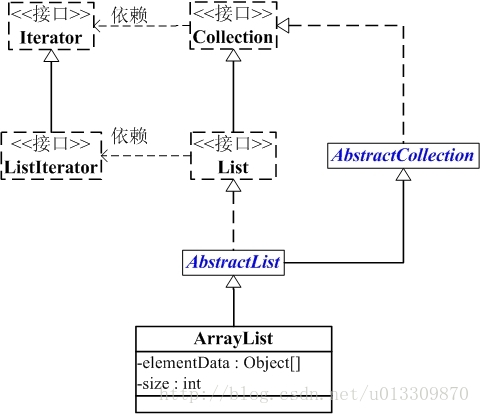一:总述:
主要讲解3个集合
1.ArrayList:
底层是数组,线程不安全;
2.LinkedList:
底层是链表,线程不安全;
3.Vector
底层数据结构是数组。线程安全;
二:ArrayList解析

首先,我们来看一下ArrayList的属性:
/**
* Default initial capacity.
*/
private static final int DEFAULT_CAPACITY = 10;//初始化容量值
/** * Shared empty array instance used for empty instances. */ private static final Object[] EMPTY_ELEMENTDATA = {};//指定ArrayList的容量为0时,返回该空数组 /** * Shared empty array instance used for default sized empty instances. We * distinguish this from EMPTY_ELEMENTDATA to know how much to inflate when * first element is added. */ private static final Object[] DEFAULTCAPACITY_EMPTY_ELEMENTDATA = {};//与上个属性的区别是:该数组是默认返回的,而上个属性是指定容量为0时返回 /** * The array buffer into which the elements of the ArrayList are stored. * The capacity of the ArrayList is the length of this array buffer. Any * empty ArrayList with elementData == DEFAULTCAPACITY_EMPTY_ELEMENTDATA * will be expanded to DEFAULT_CAPACITY when the first element is added. */ transient Object[] elementData; // non-private to simplify nested class access//第一次保存元素时,数组将会扩容 /** * The size of the ArrayList (the number of elements it contains). * * @serial */ private int size;//ArrayList的实际大小
根据上面我们可以清晰的发现:ArrayList底层其实就是一个数组,ArrayList中有扩容这么一个概念,正因为它扩容,所以它能够实现“动态”增长
1.2构造方法
/** * Constructs an empty list with the specified initial capacity. * * @param initialCapacity the initial capacity of the list * @throws IllegalArgumentException if the specified initial capacity * is negative */
//指定初始化长度initCapacity public ArrayList(int initialCapacity) { if (initialCapacity > 0) { this.elementData = new Object[initialCapacity]; } else if (initialCapacity == 0) { this.elementData = EMPTY_ELEMENTDATA; } else { throw new IllegalArgumentException("Illegal Capacity: "+ initialCapacity); } } /** * Constructs an empty list with an initial capacity of ten. */
//否则返回的是:DEFAULTCAPACITY_EMPTY_ELEMENTDATA public ArrayList() { this.elementData = DEFAULTCAPACITY_EMPTY_ELEMENTDATA; } /** * Constructs a list containing the elements of the specified * collection, in the order they are returned by the collection's * iterator. * * @param c the collection whose elements are to be placed into this list * @throws NullPointerException if the specified collection is null */ public ArrayList(Collection<? extends E> c) { elementData = c.toArray(); if ((size = elementData.length) != 0) { // c.toArray might (incorrectly) not return Object[] (see 6260652) if (elementData.getClass() != Object[].class) elementData = Arrays.copyOf(elementData, size, Object[].class); } else { // replace with empty array. this.elementData = EMPTY_ELEMENTDATA; } }
1.3 Add()方法
源码如下:
/** * Appends the specified element to the end of this list. * * @param e element to be appended to this list * @return <tt>true</tt> (as specified by {@link Collection#add}) */ public boolean add(E e) { ensureCapacityInternal(size + 1); // Increments modCount!! elementData[size++] = e; return true; } /** * Inserts the specified element at the specified position in this * list. Shifts the element currently at that position (if any) and * any subsequent elements to the right (adds one to their indices). * * @param index index at which the specified element is to be inserted * @param element element to be inserted * @throws IndexOutOfBoundsException {@inheritDoc} */ public void add(int index, E element) { rangeCheckForAdd(index); ensureCapacityInternal(size + 1); // Increments modCount!! System.arraycopy(elementData, index, elementData, index + 1, size - index); elementData[index] = element; size++; }
1.3.1 Add(E e)
步骤:
- 检查是否需要扩容
- 插入元素
首先,我们来看看这个方法:
public boolean add(E e) { ensureCapacityInternal(size + 1); // Increments modCount!! elementData[size++] = e; return true; }
该方法很短,我们可以根据方法名就猜到他是干了什么:
- 确认list容量,尝试容量加1,看看有无必要
- 添加元素
接下来我们来看看这个小容量(+1)是否满足我们的需求:
未完待续